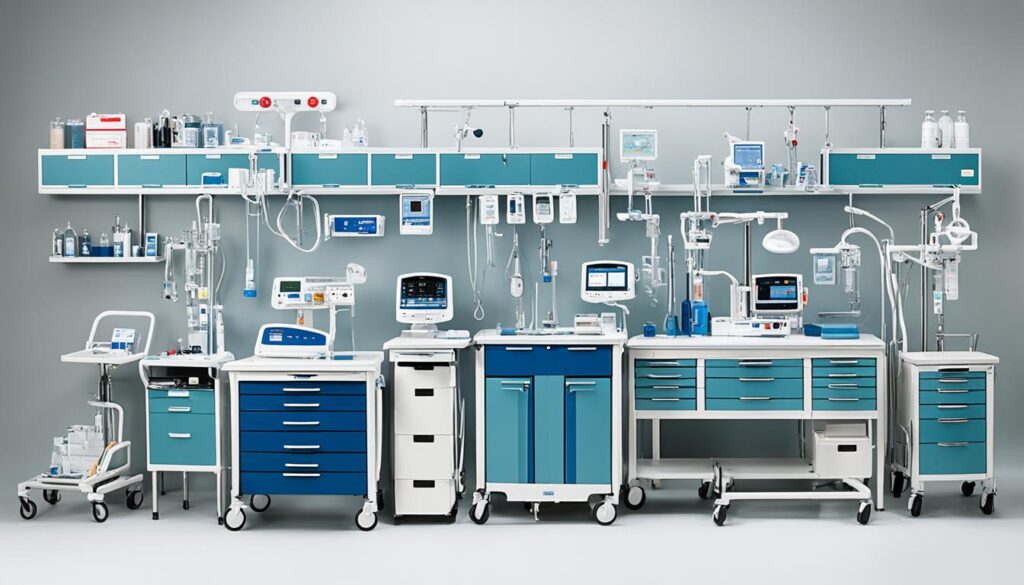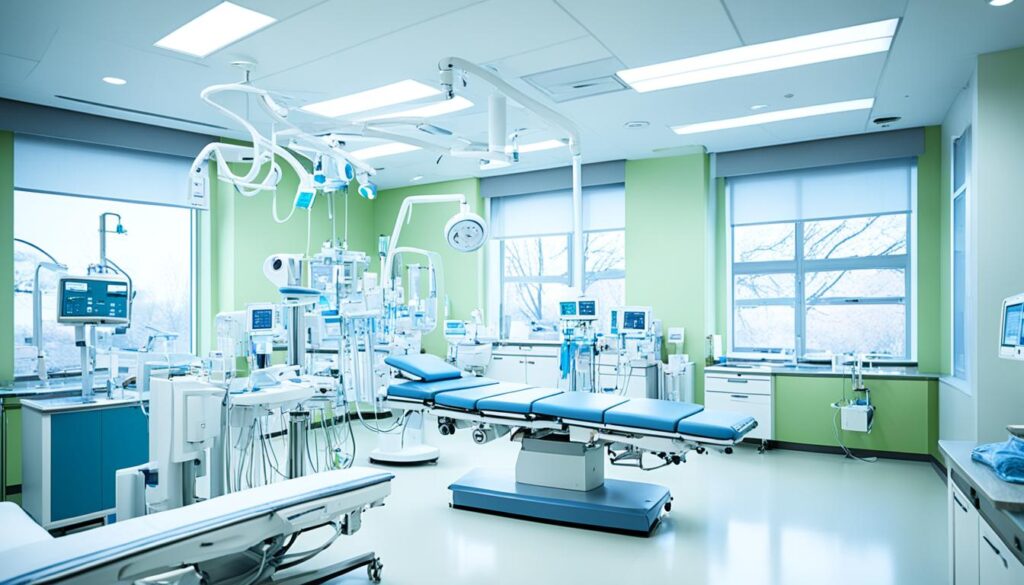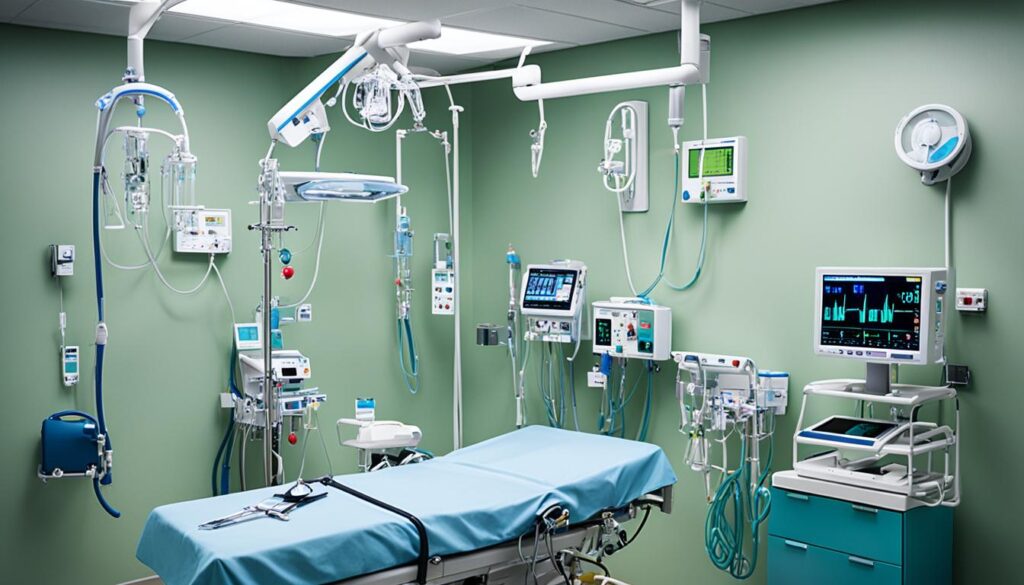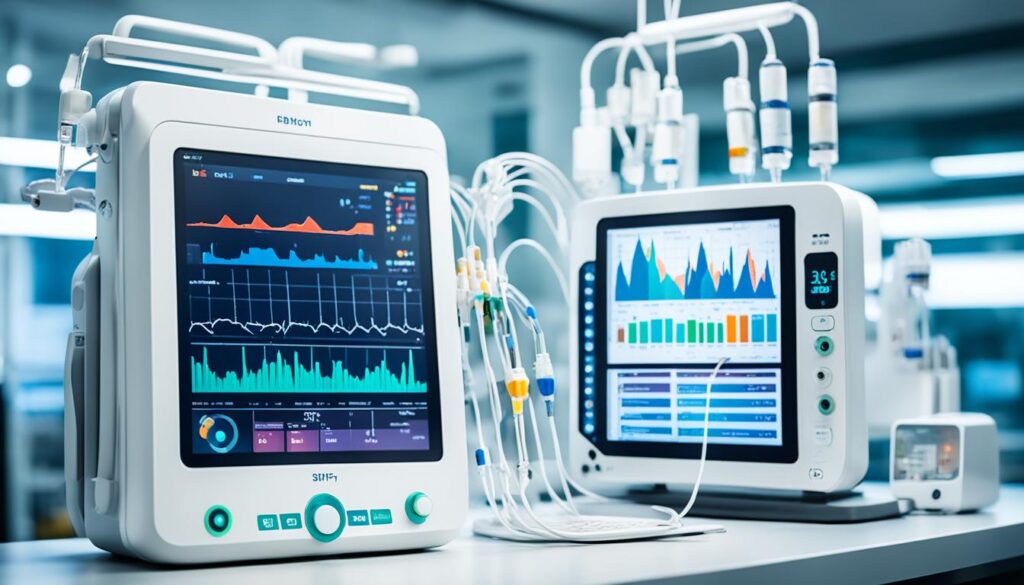Medical equipment is key for giving top-notch care in U.S. hospitals. It ranges from tools that help diagnose to machines that keep patients alive. This piece dives into the many kinds of medical gear used, like diagnostic and treatment devices. Each type has its role in caring for American patients.
Key Takeaways
- Medical equipment is essential for providing quality care in hospitals
- Diagnostic equipment includes imaging machines and other devices for testing and analysis
- Durable medical equipment (DME) helps patients manage chronic conditions and disabilities
- Treatment equipment, such as infusion pumps and surgical lasers, aids in patient therapies
- Life support systems, like heart-lung machines and medical ventilators, are critical for sustaining life
Introduction to Medical Equipment
Medical equipment is key in healthcare. It helps hospitals diagnose, treat, and watch over patients. This gear lets doctors see what’s wrong, choose the right treatments, and follow how patients are doing. Knowing about these tools is crucial for good patient care.
Importance of Medical Equipment in Hospitals
In hospitals, medical gear is essential. It lets healthcare workers do many vital tasks. For example:
- It helps find out exactly what’s wrong using special machines and tools.
- Treatments are more effective, like giving medicine with special pumps or doing surgeries with lasers.
- It keeps watch over patients’ health, spotting any danger signs early.
- And life-saving help is ready with machines such as ventilators and dialysis devices.
- This equipment makes everything run smoother and helps patients get better care.
Overview of Different Types of Equipment
Hospitals use lots of different medical tools to care for patients. Here are some main categories:
- Diagnostic tools, like X-ray machines and lab gear, to find illness or injury
- Devices patients need to recover or live, such as wheelchairs or oxygen tanks
- Equipment for procedures, including infusion pumps for medicine or lasers for surgery
- Life-saving gear, like ventilators for breathing support
- Electronic tools, such as monitors or software for keeping track of health
- Items for surgeries, like special tables or instruments
Choosing and using this equipment well is vital. It helps hospitals give top-notch healthcare to everyone who needs it.
Also Read : Medical Exam: How Do Doctors Perform A Thyroid Examination?
Diagnostic Medical Equipment
Diagnostic medical equipment is key in hospitals. It helps doctors see inside the body to know what’s wrong. They use various tools to check things like the heart’s rhythm or the size of tumors.
Also Read : Medical Care: How Do We Choose The Best Medical?
Medical Imaging Machines
Medical imaging machines take the lead in diagnosing issues. Think of X-rays, CT scans, MRIs, and ultrasounds. They let doctors see detailed images inside the body. This info is crucial for finding out what’s ailing a patient.
These machines are great for spotting many health problems. They help catch things like broken bones, odd-looking organs, or even cancer. This helps doctors figure out the best way to treat their patients.
Other Diagnostic Devices
There are many other tools that hospitals use for diagnosis. For instance, patient scales, stethoscopes, and pulse oximeters. They give facts about a patient’s weight, heartbeat, and oxygen. Knowing these things helps keep tabs on a patient’s health.
These devices are also good at finding health issues early. This early warning can start treatment sooner, making it more effective. It’s why tools that check vital signs and sounds are vital in medicine.
Also Read : Medical Treatment: How Do Doctors Decide On The Best Treatment?
| Diagnostic Medical Equipment Type | Purpose |
|---|---|
| X-ray | Captures images of the body’s internal structures, such as bones, organs, and tissues. |
| CT (Computed Tomography) Scan | Generates detailed, cross-sectional images of the body, allowing for the identification of a wide range of medical conditions. |
| MRI (Magnetic Resonance Imaging) | Uses powerful magnetic fields and radio waves to create highly detailed images of the body’s internal structures, particularly soft tissues. |
| Ultrasound | Employs high-frequency sound waves to produce real-time images of the body’s internal organs and structures, often used in obstetric and cardiovascular imaging. |
| Patient Scale | Measures a patient’s weight, a crucial vital sign for monitoring overall health and informing treatment decisions. |
| Stethoscope | Allows healthcare providers to listen to a patient’s heart, lungs, and other internal sounds, aiding in the diagnosis of various medical conditions. |
| Pulse Oximeter | Determines a patient’s oxygen saturation levels, providing valuable information about respiratory and cardiovascular function. |
Diagnostic equipment is a cornerstone of healthcare. It ranges from advanced imaging tools to simple checkup devices. These help doctors make accurate diagnoses and plan the best treatments for their patients.
Also Read : Medical Diagnosis: What Are The Steps In Diagnosing A Disease?
Durable Medical Equipment (DME)

Durable medical equipment (DME) is key for patients needing long-term support. It’s used in both hospitals and homes, as decided by doctors. DME helps patients feel safe and comfortable, offering a variety of items like wheelchairs and hospital beds. These items are made to last and work well over time.
This equipment is strong, not slippery, and holds up heavy weights. It’s crucial for taking good care of patients. DME makes life better for those with health issues. It helps them do more on their own and stay active daily.
Also Read : What Are New Technologies Affecting Lab Work In The Medical Laboratory?
What makes DME stand out from other medical tools? For starters:
- It is made to last.
- DME can be used and cleaned many times.
- It does special jobs to help with health needs.
- Each piece can be changed to fit exactly what the patient needs.
- It meets high safety and quality rules.
In hospitals, DME ensures patients get the support needed for care. It helps them at the hospital and when they go home.
| Type of Durable Medical Equipment | Examples |
|---|---|
| Mobility Aids | Wheelchairs, walkers, crutches, canes |
| Respiratory Equipment | Oxygen concentrators, ventilators, CPAP machines |
| Patient Monitoring Devices | Blood pressure monitors, glucose meters, heart rate monitors |
| Hospital Beds and Accessories | Adjustable beds, mattresses, trapeze bars |
| Other DME | Infusion pumps, home dialysis equipment, prosthetic limbs |
Choosing the right DME and using it well in health settings is very important. It makes sure patients have the best recovery. It improves how they feel and move during treatment.
“Durable medical equipment is the backbone of comprehensive patient care, providing the necessary tools and support to help individuals manage their health conditions and maintain their quality of life.”
Treatment Equipment

Medical treatment gear is very important for giving specific care and improving how patients do. These tools fix certain problems and help the body work right again. Treatment equipment in hospitals has really advanced with things like infusion pumps and surgical tools. This shows how much technology is changing medicine.
Infusion Pumps
Infusion pumps are key for giving fluids, drugs, or food straight into a person’s veins. They make sure treatments are given exactly right, which is crucial for recovery. These pumps can be small and easy to move or big for use in one place. They’re made to fit different medical needs.
Surgical Lasers and Machines
Surgical lasers and machines are at the forefront of medical gear. They let doctors do surgeries very precisely and fast. These technologies have made procedures like LASIK and heart surgeries much better. They reduce the need for big cuts and can speed up recovery. This means patients often do better.
| Treatment Equipment | Applications | Key Benefits |
|---|---|---|
| Infusion Pumps | Delivery of fluids, medications, and nutrients | Precise control, improved patient safety, and efficient administration of treatments |
| Surgical Lasers and Machines | Minimally invasive surgical procedures, such as LASIK eye surgery and cardiovascular interventions | Enhanced precision, faster recovery times, and reduced surgical risks for patients |
Treatment equipment, like infusion pumps and lasers, is vital to modern healthcare. These tools help doctors give better, more focused care. This leads to improved patient results everywhere.
Life Support Equipment

Some patients can’t keep their vital functions going. They need life support equipment to help them survive. This equipment includes heart-lung machines, medical ventilators, and dialysis machines. They are very important in intensive care units.
Heart-Lung Machines
Heart-lung machines are crucial during heart surgeries. They step in for the heart and lungs. They ensure the patient stays safe by pumping blood without the heart needing to beat. These machines are vital for surgeries on the heart.
Medical Ventilators
When patients can’t breathe on their own, ventilators help. They push air and oxygen into the lungs. This supports many conditions, like lung injuries or COPD. Ventilators can help for a short time or for longer care.
Dialysis Machines
Dialysis machines help patients with failing kidneys. They clean the blood like the kidneys normally do. This treatment is vital for those with severe kidney issues. It helps keep them healthy.
| Life Support Equipment | Function | Key Applications |
|---|---|---|
| Heart-Lung Machines | Temporarily take over the functions of the heart and lungs | Open-heart surgery and other cardiovascular procedures |
| Medical Ventilators | Provide mechanical assistance to support the respiratory system | Acute lung injuries, COPD, and other respiratory conditions |
| Dialysis Machines | Filter waste, salt, and excess fluids from the blood | End-stage renal disease and kidney failure |
This equipment is essential for patients who can’t function on their own. They take over for the heart, lungs, and kidneys. These devices are crucial in intensive care, helping patients until they recover.
Medical Laboratory Equipment

Medical laboratory equipment is critical in hospitals and labs. It helps doctors and nurses run tests on different body fluids and tissues. This includes blood, urine, and genetic samples. These tests are key for treating and keeping an eye on patients’ health.
A blood gas analyzer is essential. It tracks oxygen and other gas levels in a patient’s blood. Then there are chemistry analyzers. They look at the mix of chemicals and enzymes in the body. This helps understand the patient’s health better.
Electrolyte analyzers check important minerals in the body, like sodium and potassium. These keep our fluids and organs working right. Hematology analyzers, on the other hand, count and spot different blood cells. They help find blood problems.
This specialized equipment allows for all sorts of tests. From basic check-ups to in-depth disease screenings. These tools give doctors precise data. This helps them make the best choices for their patients.
“Medical laboratory equipment is the backbone of modern healthcare, providing the critical data needed to diagnose, treat, and monitor patients effectively.”
Storage and Transport Medical Equipment

Hospitals need special equipment to hold and move medical supplies safely. This includes case carts, storage carts, and utility carts. They’re vital for keeping medical items safe and making sure they’re on hand for the medical team. Good storage and transport are keys to keeping a hospital running smoothly.
Medical carts are important for storing medical items. They come in many sizes to fit different needs. These carts can have a range of features, including lockable areas, shelves, and even power outlets. They help keep everything secure and organized.
Another critical part is medical transport equipment. It involves stretchers, gurneys, and more for moving patients safely. These have special designs for comfort and safety. They come with features like adjustable parts and sturdy builds. This keeps both patients and hospital staff safe during transfers.
| Medical Storage Equipment | Medical Transport Equipment |
|---|---|
| Medical carts (case carts, storage carts, utility carts) | Stretchers, gurneys, patient transfer devices |
| Lockable drawers, shelves, and compartments | Adjustable heights, locking wheels, sturdy frames |
| Accommodate a range of medical supplies | Ensure comfort and safety during patient transport |
Quality medical storage and transport equipment are crucial for efficient hospital work. They help ensure quick access to hospital supplies for caring for patients best.
Electronic Medical Equipment

The healthcare world is changing fast because of electronic medical equipment. This gear helps with patient care in many ways. It tracks patient health, records data, and analyzes medical info. This makes care more tailored and effective.
Patient Monitoring Devices
Patient monitoring devices are leading the change. These sophisticated tools let doctors and nurses follow a patient’s vital signs. They look at things like heart rate, blood pressure, and how well someone is breathing. Tools such as heart rate monitors and ultrasound machines give instant health information. This can find health problems early and help with treatment.
Medical Software and Technology
Electronic medical gear also includes lots of software and technology that are changing healthcare. For example, electronic medical records make managing and sharing patient data easier. Medical imaging software makes diagnoses and treatment planning more accurate. Carts with mobile technology offer quick access to important patient info and digital resources right where care is being provided.
Bringing together electronic medical equipment, patient monitoring, medical technology, and healthcare software has a huge impact. These tools help healthcare providers make smarter choices, improve patient results, and shape the future of medicine.
| Patient Monitoring Devices | Medical Software and Technology |
|---|---|
|
|
“The integration of electronic medical equipment, patient monitoring, medical technology, and healthcare software has transformed the way healthcare is delivered.”
Surgical Medical Equipment
Surgical tools are very important for medical operations to work well. These tools include scalpels, forceps, and scissors. They are also devices like operating tables. The accuracy of these tools keeps patients safe during surgery.
Operating Tables and Stands
Operating tables are key for surgeries, giving a safe place for the patient. They support the patient’s weight and help in moving them correctly during surgery. Tables and stands for tools keep everything close for the surgical team.
Surgical Instruments
There are many types of surgical tools needed for different procedures. This list includes scalpels, forceps, scissors, and more. The tools need to be high-quality to make sure surgeons can work with care.
| Surgical Medical Equipment | Description |
|---|---|
| Operating Tables | Stable and adjustable platforms for patient positioning during surgery |
| Instrument Stands | Organized storage and easy access to surgical instruments and equipment |
| Scalpels | Precision cutting tools used for incisions and tissue dissection |
| Forceps | Grasping instruments used to hold, manipulate, or extract tissue or objects |
| Scissors | Cutting instruments for dividing tissue or suturing during surgical procedures |
Surgical tools, like operating tables and stands, are crucial for surgeries to go well. They play a big part in keeping patients safe and surgeries successful.
Acute Care Medical Equipment
In hospitals, quick treatment is key. Acute care medical equipment is vital for this. It provides prompt and efficient help to patients. Every day, these tools are used for checkups and small procedures. They make patients more comfortable and help them get better.
There are many kinds of acute care equipment. We have everything from trays and kits to wound care and monitoring gadgets. These tools are for patients needing quick help, like after surgery or for simple checkups.
Medical professionals depend on acute care supplies. Bandages, syringes, and other disposable items must be on hand for safety. There are also monitoring tools like thermometers and blood pressure cuffs. These let doctors watch a patient’s health closely.
Advanced acute care tools help with complex procedures. They include surgery kits and wound care items. These help heal injuries better and prevent infections.
Acute care gear is more than just tools. It’s the bedrock of good patient care. It gives doctors and nurses what they need for quick care. This means better health for patients.
| Type of Acute Care Equipment | Description |
|---|---|
| General-Purpose Trays | Sterile trays containing a variety of tools and supplies for minor medical procedures |
| Minor Procedure Kits | Specialized kits containing the necessary instruments for performing minor surgical interventions |
| Wound and Skin Care Products | Bandages, dressings, and other supplies designed to promote healing and prevent infection |
| Monitoring Devices | Equipment such as thermometers, blood pressure cuffs, and pulse oximeters for tracking patient vital signs |
| Non-Surgical Instruments | A variety of tools and equipment used for routine patient care and minor medical procedures |
Acute care equipment is vital in healthcare. It ensures quality care in hospitals. From basics to specialized equipment, all of it helps patients feel safe and cared for.
Medical Equipment
Hospitals use many high-tech tools to provide excellent care. They rely on things like advanced imaging machines and life support systems. These tools are always getting better as medical science moves forward.
To help patients in the best way, hospitals and clinics need the newest medical devices, healthcare technology, and medical supplies. Our understanding and equipment are always improving. This allows doctors and nurses to save more lives and make patients’ health better.
Evolving Medical Technologies
New hospital equipment and medical devices are always coming out. They make it easier for healthcare workers to do their jobs. Modern medical imaging machines and life-support systems are some examples. They’re designed to be more precise and effective for patient care.
As healthcare Technology develops, hospitals and clinics must transform too. They need to keep up with new medical supplies and equipment for the best patient care. By staying current with technology, healthcare providers can improve how well patients do and save more lives.
“The constant advancement of medical technology is transforming the way we deliver healthcare, empowering us to provide more accurate diagnoses, targeted treatments, and improved patient outcomes.”
The medical world is always working to be better for patients. With new hospital equipment, medical devices, and healthcare technology, this mission is clearer every day. Hospitals and clinics invest in the latest medical supplies to keep offering top-notch care.
Also Read: What Are The Future Trends In Medical Technology?
Conclusion
The equipment in hospitals is very important. It helps doctors and nurses care for patients in the best way possible. This equipment includes medical equipment, hospital equipment, and healthcare technology. They keep an eye on patients, help with treatments, and make patient care better.
Hospitals’ equipment keeps getting better. It uses the newest technology. This means doctors can diagnose better, treat patients more personally, and everyone has a better medical experience. Knowing about the various types of medical equipment and how they work is key. It helps hospitals keep up with the changing healthcare needs of their areas.
Medical equipment is vital for hospitals. It is the foundation of excellent healthcare today. This equipment gives healthcare workers what they need to be great at taking care of patients.
FAQs
What are the different types of medical equipment used in hospitals?
Types of medical equipment in hospitals are many. They include tools for diagnosis, durable devices for long-term use, and those for treating patients. There is also equipment for life support, technology tools, surgical procedures, and acute care.
What is the importance of medical equipment in hospitals?
Medical tools are key for top-notch patient care in hospitals. They help doctors check a patient’s health, choose the right treatments, and see how they’re doing. This care is vital for patients to recover well.
What are some examples of diagnostic medical equipment?
Imaging machines like X-rays, CT scans, and MRIs help figure out what’s wrong. Tools such as stethoscopes and pulse oximeters are also used. They assist doctors in creating the best plans for treatment.
What is Durable Medical Equipment (DME)?
DME is equipment that patients might use for a long time. It includes wheelchairs and hospital beds. These items are strong and help patients move or stay comfortable.
What are some examples of treatment equipment?
Treatment equipment includes devices that help fix health problems. For example, there are pumps for giving patients medicine. There are also surgical lasers for operations.
What is life support equipment?
Life support gear is vital for patients who can’t function on their own. Machines such as ventilators and dialysis machines help keep patients alive. This support is key in intensive care units.
What types of equipment are used in medical laboratories?
Lab tools include analyzers for blood and urine, and other samples. They make sure that doctors get accurate test results. This information is crucial for choosing the right treatments.
What is storage and transport medical equipment?
These tools help move and store medical supplies safely. They include carts and case containers. Organizing and moving equipment correctly keeps hospitals running smoothly.
What is electronic medical equipment?
Electronic devices help with patient data in hospitals. This includes everything from patient monitors to software for medical records. These gadgets help doctors keep a close eye on their patients.
What types of equipment are used in surgical procedures?
For surgeries, there are special tools like scalpels and scissors. They work with bigger items such as operation tables. The right tools are important for safe and successful surgeries.
What is acute care medical equipment?
Acute care items are used daily for quick treatments. They include trays, kits for minor procedures, and devices for checking patients. Having these basic tools is essential for caring for patients right away.
Source Links
- https://harmonyhomemedical.com/blogs/home-medical-resources/all-types-of-medical-equipment
- https://www.alimed.com/a-brief-guide-to-hospital-equipment-blog/
- https://www.linkedin.com/pulse/different-types-medical-equipment-hospital-

